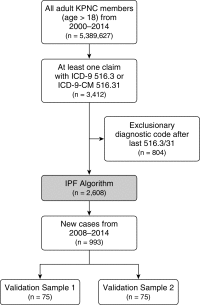Code-based Diagnostic Algorithms for Idiopathic Pulmonary Fibrosis. Case Validation and Improvement
- PMID: 28355518
- PMCID: PMC5566307
- DOI: 10.1513/AnnalsATS.201610-764OC
Code-based Diagnostic Algorithms for Idiopathic Pulmonary Fibrosis. Case Validation and Improvement
Abstract
Rationale: Population-based studies of idiopathic pulmonary fibrosis (IPF) in the United States have been limited by reliance on diagnostic code-based algorithms that lack clinical validation.
Objectives: To validate a well-accepted International Classification of Diseases, Ninth Revision, code-based algorithm for IPF using patient-level information and to develop a modified algorithm for IPF with enhanced predictive value.
Methods: The traditional IPF algorithm was used to identify potential cases of IPF in the Kaiser Permanente Northern California adult population from 2000 to 2014. Incidence and prevalence were determined overall and by age, sex, and race/ethnicity. A validation subset of cases (n = 150) underwent expert medical record and chest computed tomography review. A modified IPF algorithm was then derived and validated to optimize positive predictive value.
Results: From 2000 to 2014, the traditional IPF algorithm identified 2,608 cases among 5,389,627 at-risk adults in the Kaiser Permanente Northern California population. Annual incidence was 6.8/100,000 person-years (95% confidence interval [CI], 6.1-7.7) and was higher in patients with older age, male sex, and white race. The positive predictive value of the IPF algorithm was only 42.2% (95% CI, 30.6 to 54.6%); sensitivity was 55.6% (95% CI, 21.2 to 86.3%). The corrected incidence was estimated at 5.6/100,000 person-years (95% CI, 2.6-10.3). A modified IPF algorithm had improved positive predictive value but reduced sensitivity compared with the traditional algorithm.
Conclusions: A well-accepted International Classification of Diseases, Ninth Revision, code-based IPF algorithm performs poorly, falsely classifying many non-IPF cases as IPF and missing a substantial proportion of IPF cases. A modification of the IPF algorithm may be useful for future population-based studies of IPF.
Keywords: idiopathic pulmonary fibrosis; incidence; prevalence.
Figures


Comment in
-
Refining the Burden of Idiopathic Pulmonary Fibrosis: The Cocktail Party Effect.Ann Am Thorac Soc. 2017 Jun;14(6):829-830. doi: 10.1513/AnnalsATS.201703-234ED. Ann Am Thorac Soc. 2017. PMID: 28570156 No abstract available.
References
-
- Raghu G, Collard HR, Egan JJ, Martinez FJ, Behr J, Brown KK, Colby TV, Cordier JF, Flaherty KR, Lasky JA, et al. ATS/ERS/JRS/ALAT Committee on Idiopathic Pulmonary Fibrosis. An official ATS/ERS/JRS/ALAT statement: idiopathic pulmonary fibrosis: evidence-based guidelines for diagnosis and management. Am J Respir Crit Care Med. 2011;183:788–824. - PMC - PubMed
-
- Hutchinson J, Fogarty A, Hubbard R, McKeever T. Global incidence and mortality of idiopathic pulmonary fibrosis: a systematic review. Eur Respir J. 2015;46:795–806. - PubMed
-
- Raghu G, Chen SY, Yeh WS, Maroni B, Li Q, Lee YC, Collard HR.Idiopathic pulmonary fibrosis in US Medicare beneficiaries aged 65 years and older: incidence, prevalence, and survival, 2001–11 Lancet Respir Med 20142566–572.[Published erratum appears in Lancet Respir Med 2014;2:e12.] - PubMed
-
- Raghu G, Weycker D, Edelsberg J, Bradford WZ, Oster G. Incidence and prevalence of idiopathic pulmonary fibrosis. Am J Respir Crit Care Med. 2006;174:810–816. - PubMed
-
- Esposito DB, Lanes S, Donneyong M, Holick CN, Lasky JA, Lederer D, Nathan SD, O’Quinn S, Parker J, Tran TN. Idiopathic pulmonary fibrosis in United States automated claims: incidence, prevalence, and algorithm validation. Am J Respir Crit Care Med. 2015;192:1200–1207. - PubMed
Publication types
MeSH terms
Grants and funding
LinkOut - more resources
Full Text Sources
Other Literature Sources

